Takeo Igarashi
Real-Time Per-Garment Virtual Try-On with Temporal Consistency for Loose-Fitting Garments
Jun 14, 2025Abstract:Per-garment virtual try-on methods collect garment-specific datasets and train networks tailored to each garment to achieve superior results. However, these approaches often struggle with loose-fitting garments due to two key limitations: (1) They rely on human body semantic maps to align garments with the body, but these maps become unreliable when body contours are obscured by loose-fitting garments, resulting in degraded outcomes; (2) They train garment synthesis networks on a per-frame basis without utilizing temporal information, leading to noticeable jittering artifacts. To address these challenges, we propose a two-stage approach for robust semantic map estimation. First, we extract a garment-invariant representation from the raw input image. This representation is then passed through an auxiliary network to estimate the semantic map. This enhances the robustness of semantic map estimation under loose-fitting garments during garment-specific dataset generation. Furthermore, we introduce a recurrent garment synthesis framework that incorporates temporal dependencies to improve frame-to-frame coherence while maintaining real-time performance. We conducted qualitative and quantitative evaluations to demonstrate that our method outperforms existing approaches in both image quality and temporal coherence. Ablation studies further validate the effectiveness of the garment-invariant representation and the recurrent synthesis framework.
Low-Barrier Dataset Collection with Real Human Body for Interactive Per-Garment Virtual Try-On
Jun 12, 2025Abstract:Existing image-based virtual try-on methods are often limited to the front view and lack real-time performance. While per-garment virtual try-on methods have tackled these issues by capturing per-garment datasets and training per-garment neural networks, they still encounter practical limitations: (1) the robotic mannequin used to capture per-garment datasets is prohibitively expensive for widespread adoption and fails to accurately replicate natural human body deformation; (2) the synthesized garments often misalign with the human body. To address these challenges, we propose a low-barrier approach for collecting per-garment datasets using real human bodies, eliminating the necessity for a customized robotic mannequin. We also introduce a hybrid person representation that enhances the existing intermediate representation with a simplified DensePose map. This ensures accurate alignment of synthesized garment images with the human body and enables human-garment interaction without the need for customized wearable devices. We performed qualitative and quantitative evaluations against other state-of-the-art image-based virtual try-on methods and conducted ablation studies to demonstrate the superiority of our method regarding image quality and temporal consistency. Finally, our user study results indicated that most participants found our virtual try-on system helpful for making garment purchasing decisions.
Automating eHMI Action Design with LLMs for Automated Vehicle Communication
May 27, 2025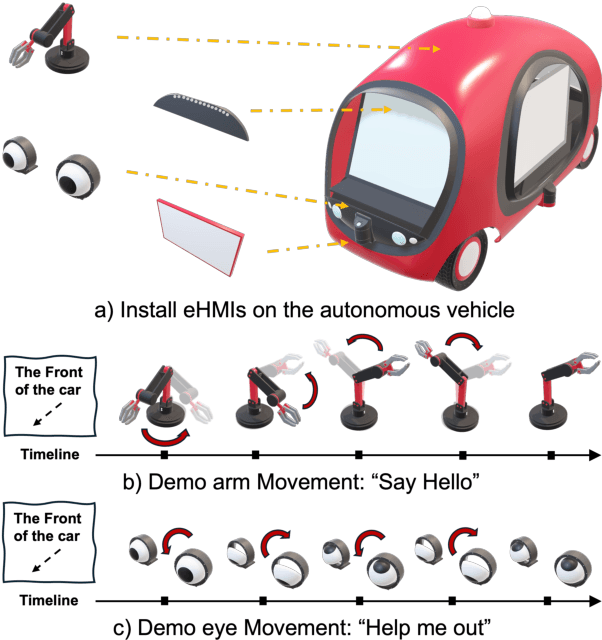
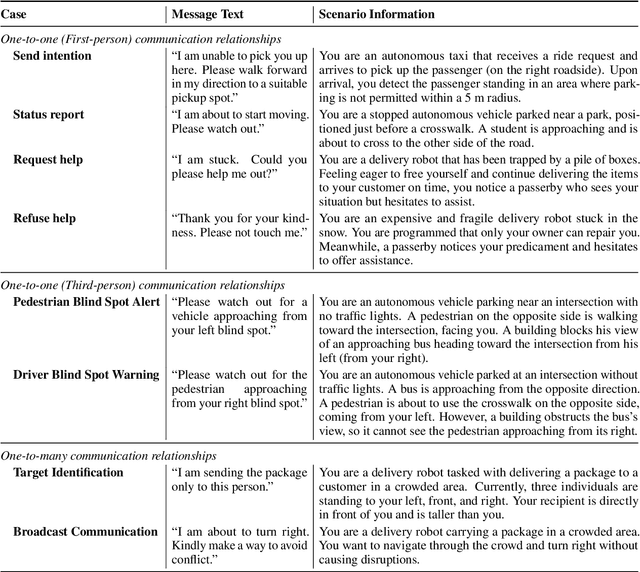
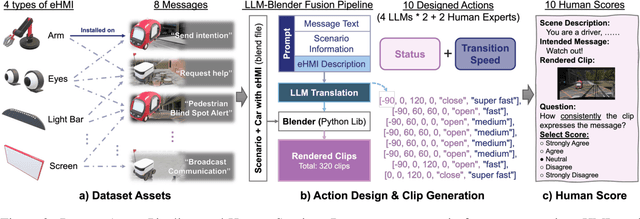

Abstract:The absence of explicit communication channels between automated vehicles (AVs) and other road users requires the use of external Human-Machine Interfaces (eHMIs) to convey messages effectively in uncertain scenarios. Currently, most eHMI studies employ predefined text messages and manually designed actions to perform these messages, which limits the real-world deployment of eHMIs, where adaptability in dynamic scenarios is essential. Given the generalizability and versatility of large language models (LLMs), they could potentially serve as automated action designers for the message-action design task. To validate this idea, we make three contributions: (1) We propose a pipeline that integrates LLMs and 3D renderers, using LLMs as action designers to generate executable actions for controlling eHMIs and rendering action clips. (2) We collect a user-rated Action-Design Scoring dataset comprising a total of 320 action sequences for eight intended messages and four representative eHMI modalities. The dataset validates that LLMs can translate intended messages into actions close to a human level, particularly for reasoning-enabled LLMs. (3) We introduce two automated raters, Action Reference Score (ARS) and Vision-Language Models (VLMs), to benchmark 18 LLMs, finding that the VLM aligns with human preferences yet varies across eHMI modalities.
Proactive Conversational Agents with Inner Thoughts
Dec 31, 2024Abstract:One of the long-standing aspirations in conversational AI is to allow them to autonomously take initiatives in conversations, i.e., being proactive. This is especially challenging for multi-party conversations. Prior NLP research focused mainly on predicting the next speaker from contexts like preceding conversations. In this paper, we demonstrate the limitations of such methods and rethink what it means for AI to be proactive in multi-party, human-AI conversations. We propose that just like humans, rather than merely reacting to turn-taking cues, a proactive AI formulates its own inner thoughts during a conversation, and seeks the right moment to contribute. Through a formative study with 24 participants and inspiration from linguistics and cognitive psychology, we introduce the Inner Thoughts framework. Our framework equips AI with a continuous, covert train of thoughts in parallel to the overt communication process, which enables it to proactively engage by modeling its intrinsic motivation to express these thoughts. We instantiated this framework into two real-time systems: an AI playground web app and a chatbot. Through a technical evaluation and user studies with human participants, our framework significantly surpasses existing baselines on aspects like anthropomorphism, coherence, intelligence, and turn-taking appropriateness.
RoCap: A Robotic Data Collection Pipeline for the Pose Estimation of Appearance-Changing Objects
Jul 10, 2024



Abstract:Object pose estimation plays a vital role in mixed-reality interactions when users manipulate tangible objects as controllers. Traditional vision-based object pose estimation methods leverage 3D reconstruction to synthesize training data. However, these methods are designed for static objects with diffuse colors and do not work well for objects that change their appearance during manipulation, such as deformable objects like plush toys, transparent objects like chemical flasks, reflective objects like metal pitchers, and articulated objects like scissors. To address this limitation, we propose Rocap, a robotic pipeline that emulates human manipulation of target objects while generating data labeled with ground truth pose information. The user first gives the target object to a robotic arm, and the system captures many pictures of the object in various 6D configurations. The system trains a model by using captured images and their ground truth pose information automatically calculated from the joint angles of the robotic arm. We showcase pose estimation for appearance-changing objects by training simple deep-learning models using the collected data and comparing the results with a model trained with synthetic data based on 3D reconstruction via quantitative and qualitative evaluation. The findings underscore the promising capabilities of Rocap.
Automatic Dance Video Segmentation for Understanding Choreography
May 30, 2024Abstract:Segmenting dance video into short movements is a popular way to easily understand dance choreography. However, it is currently done manually and requires a significant amount of effort by experts. That is, even if many dance videos are available on social media (e.g., TikTok and YouTube), it remains difficult for people, especially novices, to casually watch short video segments to practice dance choreography. In this paper, we propose a method to automatically segment a dance video into each movement. Given a dance video as input, we first extract visual and audio features: the former is computed from the keypoints of the dancer in the video, and the latter is computed from the Mel spectrogram of the music in the video. Next, these features are passed to a Temporal Convolutional Network (TCN), and segmentation points are estimated by picking peaks of the network output. To build our training dataset, we annotate segmentation points to dance videos in the AIST Dance Video Database, which is a shared database containing original street dance videos with copyright-cleared dance music. The evaluation study shows that the proposed method (i.e., combining the visual and audio features) can estimate segmentation points with high accuracy. In addition, we developed an application to help dancers practice choreography using the proposed method.
FontCLIP: A Semantic Typography Visual-Language Model for Multilingual Font Applications
Mar 11, 2024Abstract:Acquiring the desired font for various design tasks can be challenging and requires professional typographic knowledge. While previous font retrieval or generation works have alleviated some of these difficulties, they often lack support for multiple languages and semantic attributes beyond the training data domains. To solve this problem, we present FontCLIP: a model that connects the semantic understanding of a large vision-language model with typographical knowledge. We integrate typography-specific knowledge into the comprehensive vision-language knowledge of a pretrained CLIP model through a novel finetuning approach. We propose to use a compound descriptive prompt that encapsulates adaptively sampled attributes from a font attribute dataset focusing on Roman alphabet characters. FontCLIP's semantic typographic latent space demonstrates two unprecedented generalization abilities. First, FontCLIP generalizes to different languages including Chinese, Japanese, and Korean (CJK), capturing the typographical features of fonts across different languages, even though it was only finetuned using fonts of Roman characters. Second, FontCLIP can recognize the semantic attributes that are not presented in the training data. FontCLIP's dual-modality and generalization abilities enable multilingual and cross-lingual font retrieval and letter shape optimization, reducing the burden of obtaining desired fonts.
Efficient Human-in-the-loop System for Guiding DNNs Attention
Jun 14, 2022
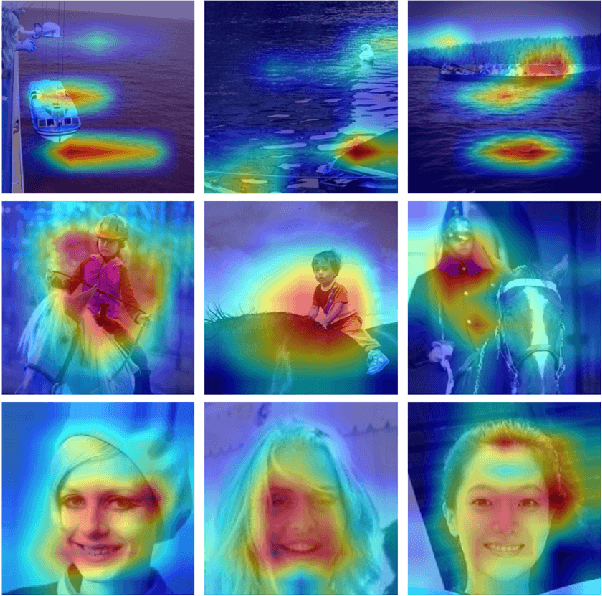
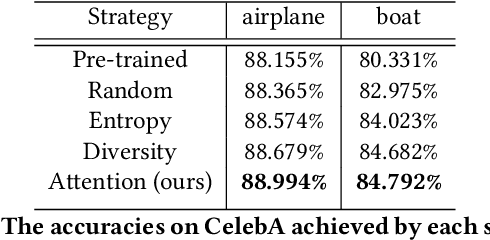

Abstract:Attention guidance is an approach to addressing dataset bias in deep learning, where the model relies on incorrect features to make decisions. Focusing on image classification tasks, we propose an efficient human-in-the-loop system to interactively direct the attention of classifiers to the regions specified by users, thereby reducing the influence of co-occurrence bias and improving the transferability and interpretability of a DNN. Previous approaches for attention guidance require the preparation of pixel-level annotations and are not designed as interactive systems. We present a new interactive method to allow users to annotate images with simple clicks, and study a novel active learning strategy to significantly reduce the number of annotations. We conducted both a numerical evaluation and a user study to evaluate the proposed system on multiple datasets. Compared to the existing non-active-learning approach which usually relies on huge amounts of polygon-based segmentation masks to fine-tune or train the DNNs, our system can save lots of labor and money and obtain a fine-tuned network that works better even when the dataset is biased. The experiment results indicate that the proposed system is efficient, reasonable, and reliable.
AutoPoly: Predicting a Polygonal Mesh Construction Sequence from a Silhouette Image
Mar 29, 2022



Abstract:Polygonal modeling is a core task of content creation in Computer Graphics. The complexity of modeling, in terms of the number and the order of operations and time required to execute them makes it challenging to learn and execute. Our goal is to automatically derive a polygonal modeling sequence for a given target. Then, one can learn polygonal modeling by observing the resulting sequence and also expedite the modeling process by starting from the auto-generated result. As a starting point for building a system for 3D modeling in the future, we tackle the 2D shape modeling problem and present AutoPoly, a hybrid method that generates a polygonal mesh construction sequence from a silhouette image. The key idea of our method is the use of the Monte Carlo tree search (MCTS) algorithm and differentiable rendering to separately predict sequential topological actions and geometric actions. Our hybrid method can alter topology, whereas the recently proposed inverse shape estimation methods using differentiable rendering can only handle a fixed topology. Our novel reward function encourages MCTS to select topological actions that lead to a simpler shape without self-intersection. We further designed two deep learning-based methods to improve the expansion and simulation steps in the MCTS search process: an $n$-step "future action prediction" network (nFAP-Net) to generate candidates for potential topological actions, and a shape warping network (WarpNet) to predict polygonal shapes given the predicted rendered images and topological actions. We demonstrate the efficiency of our method on 2D polygonal shapes of multiple man-made object categories.
Per Garment Capture and Synthesis for Real-time Virtual Try-on
Sep 10, 2021



Abstract:Virtual try-on is a promising application of computer graphics and human computer interaction that can have a profound real-world impact especially during this pandemic. Existing image-based works try to synthesize a try-on image from a single image of a target garment, but it inherently limits the ability to react to possible interactions. It is difficult to reproduce the change of wrinkles caused by pose and body size change, as well as pulling and stretching of the garment by hand. In this paper, we propose an alternative per garment capture and synthesis workflow to handle such rich interactions by training the model with many systematically captured images. Our workflow is composed of two parts: garment capturing and clothed person image synthesis. We designed an actuated mannequin and an efficient capturing process that collects the detailed deformations of the target garments under diverse body sizes and poses. Furthermore, we proposed to use a custom-designed measurement garment, and we captured paired images of the measurement garment and the target garments. We then learn a mapping between the measurement garment and the target garments using deep image-to-image translation. The customer can then try on the target garments interactively during online shopping.
 Add to Chrome
Add to Chrome Add to Firefox
Add to Firefox Add to Edge
Add to Edge